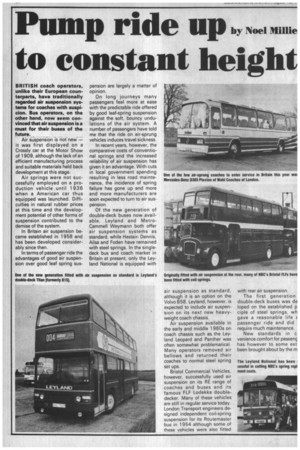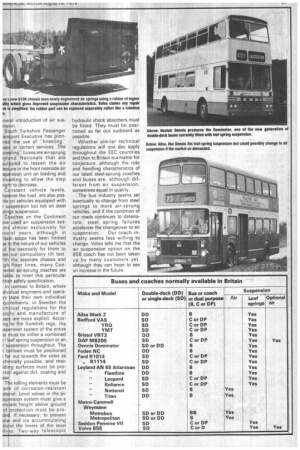P ump ride up by Noel Millie
Page 28

Page 29

If you've noticed an error in this article please click here to report it so we can fix it.
to constant height
BRITISH coach operators, unlike their European counterparts, have traditionally regarded air suspension systems for coaches with suspicion. Bus operators, on the other hand, now seem convinced that air suspension is a must for their buses of the future. _ Air suspension is not new — it was first displayed on a Crossly car at the Motor Show of 1909, although the lack of an efficient manufacturing process and suitable materials held back development at this stage.
Air springs were not successfully employed on a production vehicle until 1936 when a American car thus equipped was launched. Difficulties in natural rubber prices at this time and the development potential of other forms of suspension contributed to the demise of the system In Britain air suspension became established in 1958 and has been developed considerably since then.
In terms of passenger ride the advantages of good air suspension over good leaf spring sus
pension are largely a matter of opinion.
On long journeys many passengers feel more at ease with the predictable ride offered by good leaf-spring suspension against the soft, bouncy undulations of the air system. A number of passengers have told me that the ride on air-sprung vehicles induces travel sickness.
In recent years, however, the comparative costs of conventional springs and the increased reliability of air suspension has given it an advantage. With cuts in local government spending resulting in less road maintenance, the incidence of spring failure has gone up and more and more manufacturers are soon expected to turn to air suspension.
Of the new generation of double-deck buses now available, Leyland and MetroCammell Weymann both offer air suspension systems as standard, while HestairDennis, Ailsa and Foden have remained with steel springs. In the singledeck bus and coach market in Britain at present, only the Leyland National is equipped with air suspension as standard, although it is an option on the Volvo B58. Leyland, however, is expected to include air suspension on its next new heavyweight coach chassis.
Air suspension available in the early and middle 1960s on coach chassis such as the Leyland Leopard and Panther was often somewhat problematical. Many operators removed air bellows and returned their coaches to normal steel spring set ups.
Bristol Commercial Vehicles, however, successfully used air suspension on its RE range of coaches and buses and its famous ELF Lodekka doubledecker. Many of these vehicles are still in regular service today. London Transport engineers designed independent coil-spring suspension for its Routemaster bus in 1954 although some of these vehicles were also fitted with rear air suspension.
The first generation double-deck buses was de loped on the established p ciple of steel springs, wh gave a reasonable life z passenger ride and did require much maintenance.
New standards in c venience comfort for passenc has however to some ext been brought about by the m ineral introduction of air sus
South Yorkshire Passenger anEport Executive has pionired the use of "'kneelingJses or certain services. The cneelingbuses are air-sprung !ylEnd Nationals that are iuipped to lessen the air ess ire in the front nearside air ispension unit on loading and 'loading to allow the step ight to decrease.
Ccnstant vehicle levels, hatever the load, are also posple on vehicles equipped with r suspension but not on steel irinjs suspension.
Coaches on the Continent lye used air suspension sys
ms almost exclusively for ive-al years, although in -itain scope has been limited ie tp the nature of our vehicles id he necessity for them to )ss our compulsory tilt test. fith the separate chassis and
gh floor lines, many Coniental air-sprung coaches are lable to meet this particular ritish safety specification.
In contrast to Britain, where div dual engineers and operars state their own individual .qu rements, in Sweden the chnical regulations for the ipply and manufacture of nes are more explicit. Accorng to the Swedish regs, the ispension system of the entire Js must be either a combined r/leaf spring suspension or an. r suspension throughout. The r bellows must be positioned ; far out towards the sides as ch ically possible, and their iding surfaces must be procted against dirt, coating and ear.
The rolling elements must be ade of corrosion-resistant aterial. Level valves in the air ispansion system must give a ms ant height above ground id protection must be pro ded, if necessary, to prevent low and ice accummulating ou id the levers of the level )Ivas. Two-way telescopic hydraulic shock absorbers must be fitted. They must be positioned as far out outboard as possible.
Whether similar technical regulations will one day apply throughout the EEC countries and then to Britain is a matter for conjecture, although the ride and handling characteristics of our latest steel-sprung coaches and buses are, although different from air suspension, sometimes equal in quality.
The bus industry seems set eventually to change from steel .springs to more air-sprung vehicles, and if the condition of our roads continues to deteriorate, steel spring failures accelerate the changeover to air
suspension. Our coach industry seems less willing to change. Volvo tells me that the air suspension option on the B58 coach has not been taken up by many customers yet, although they can hope to see an increase in the future.
















































































































